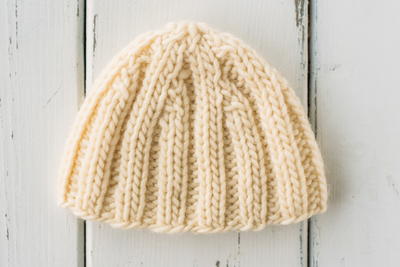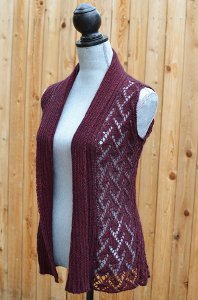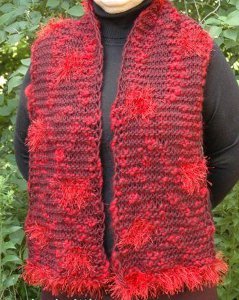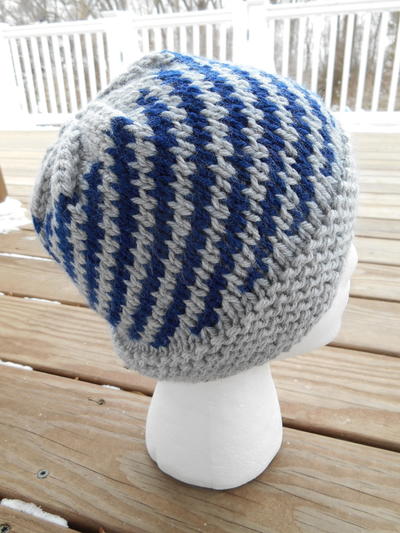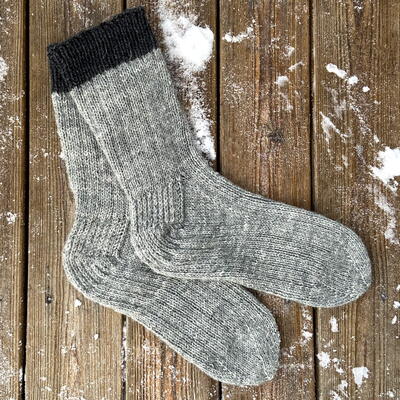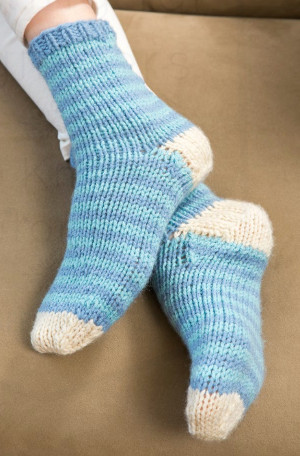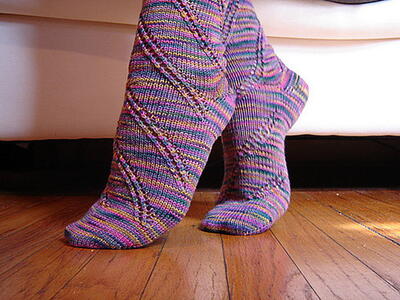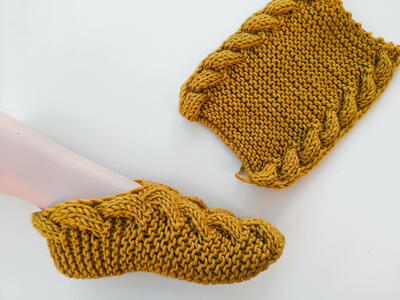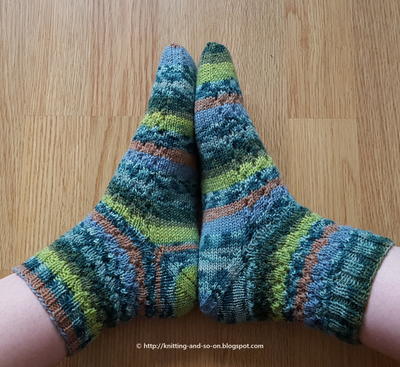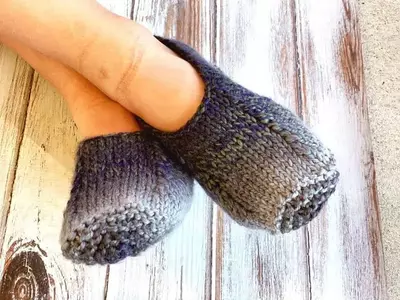Serendipity Socks
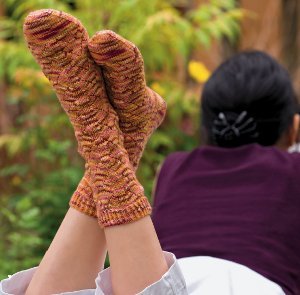
Get ready for summer with lightweight free sock knitting patterns like this one for colorful Serendipity Socks! Knit up these richly textured socks with a series of simple knit stitches and yarn overs. Directions are written for knitting with circular needles, but they can easily be converted to five dpns.

Knitting Needle Size1 or 2.25 mm, Circular Knitting Needles
Yarn Weight(2) Fine (23-26 stitches to 4 inches)
Size: Women's Medium
Materials
- 1 skein of Creamy Sock from Crazy4Dyeing; Ellie Putz, dyer (80% milk protein, 20% wool; 100 g; 360 yds) in color Autumn Mist
- 2 circular needles in size 1 (2.25 mm)
- or size required for gauge
- Tapestry needle
Gauge: 8½ sts = 1" in serendipity patt worked in the rnd
OPTIONS FOR LARGER SIZES
Option 1: CO 76 sts. Follow patt rep on chart for 76-st CO, and work short-row heel on 38 sts.
Work short-row heel until there are 13 st/YO pairs.
Option 2: Use size 2 (2.75 mm) needles and a heavier yarn, such as Crazy4Dyeing’s ZestySock or JollySock.
NEEDLE CHOICES
Directions are written for knitting in the round on 2 circular needles, but they can be easily converted to one circular needle or five double-pointed needles. For one circular needle, divide the stitches in half with the cable loop of the long circular needle. For double-pointed needles, divide the stitches evenly among 4 needles.
Serendipity Pattern (chart below)
Written insructions below are for 68-st CO. For 76-st CO, see chart.
Rnd 1: *K1, K2tog, K5, YO, K1, YO K5, ssk, K1; rep from *.
Rnds 2, 4, 6, 8, and 10: Knit.
Rnd 3: *K1, K2tog, K4, YO, K3, YO, K4, ssk, K1; rep from *.
Rnd 5: *K1, K2tog, K3, YO, K5, YO, K3, ssk, K1; rep from *.
Rnd 7: *K1, K2tog, K2, YO, K7, YO, K2, ssk, K1; rep from *.
Rnd 9: *K1, K2tog, K1, YO, K9, YO, K1, ssk, K1; rep from *.
Rnd 11: *K1, K2tog, YO, K11, YO, ssk, K1; rep from *.
Rnd 12: Knit.
Rep rnds 1–12 for patt.
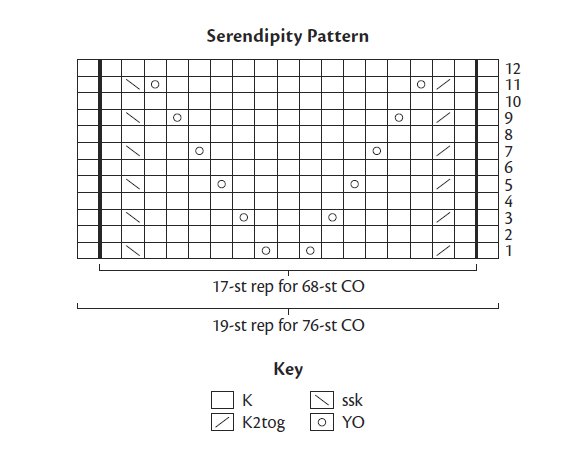
Cuff
CO 68 sts loosely. Divide sts evenly on 2 circular needles; 34 heel sts on needle 1, and 34 instep sts on needle 2. Join, being careful not to twist sts. Work P1, K1 tbl ribbing for 12 rows (approx ¾").
Leg
Knit 1 rnd. Beg Serendipity patt and work 5 complete vertical reps, then work rnds 1–11 once more (approx 6 5⁄8").
Short-Row Heel
Heel is worked back and forth on the 34 sts on needle 1.
Row 1 (RS): Knit until 1 st rems, turn.
Row 2: YO, purl until 1 st rems, turn.
Row 3: YO, knit to first st/YO pair, turn.
Row 4: YO, purl to first st/YO pair, turn.
Rep rows 3 and 4 until each end of needle has one st on the end, and 11 st/YO pairs. This will occur when you are ready to beg a RS row.
Row 5 (RS): Knit to first st/YO pair. K1 (st from the st/YO pair), K2tog, turn.
Row 6: YO, purl to first st/YO pair. P1 (st from the st/YO pair), ssp, turn.
Row 7: YO, knit to first YO and K3tog (knit 2 YOs and following st tog), turn.
Row 8: YO, purl to first YO, sssp (purl 2 YOs and following st tog), turn.
Rep rows 7 and 8 until last st on each end is worked. This will be a WS row.
Foot
Transition Round
Needle 1 (sole): YO, knit to last st (last YO) on this needle. Sl this
st to needle 2, which is holding instep sts.
Needle 2 (instep): Knit the transferred st tog with the first instep st, counting it as first patt st of rnd 12.
Work instep in patt to last st.
Move YO at beg of heel needle to instep needle and ssk tog with last
instep st, counting it as last patt st of rnd 1.
Cont needle 1 in St st and needle 2 in patt until 7½" or 2" less than desired foot length.
Toe
Rnd 1: Knit.
Rnd 2: K1, ssk, knit to last 3 sts, K2tog, K1. Rep for both needles.
Work rnds 1 and 2 until 10 sts rem on each needle (20 sts total).
Graft toe sts tog using Kitchener st or desired grafting method. Weave in ends.
Knitting with One Circular Needle
This method allows you to knit in the round using only one needle—a long circular needle with a flexible cable. Cast on the required number of stitches. Find the halfway point of the stitches and pull the cable out at that point to make a loop. Half the stitches are now on the front part of the cable and half are on the back. With the needle tips facing toward the right, pull the back needle out far enough to knit the stitches on the front cable. When the front stitches are all worked, turn the work so the needle tips are facing right once again. Work the second half of the stitches just as you did the first half.
Grafting or Kitchener Stitch
Use this technique to sew the ends of the toes together. Work with the two pieces on the needles with wrong sides together, one needle behind the other. Thread a tapestry needle with the yarn attached to the back needle and work as follows:
Insert the tapestry needle into the first stitch of the front needle as if to purl, pull the yarn through but leave the stitch on the knitting needle. Go to the back needle, being careful to take the yarn under the knitting needle each time. Insert the tapestry needle into the first stitch as if to knit, pull the yarn through but leave the stitch on the knitting needle. *Insert the tapestry needle into the first stitch of the front needle as if to knit, and then slip this stitch off the needle. Insert the yarn needle into the next stitch of the front needle as if to purl, pull the yarn through but leave the stitch on the knitting needle. Go to the back needle and insert the yarn needle into the first stitch as if to purl. Take this stitch off and onto the tapestry needle. Put the tapestry needle through the next stitch of the back needle as if to knit. Pull the yarn through, but leave this stitch on the knitting needle. *
Rep from * to * until all stitches are joined. Do not draw the yarn too tightly. The stitches should have the same tension as the knitted stitches. Fasten the end securely.
Here’s a shorthand way of remembering how the grafting is done:
Front needle: Knit off, purl on.
Back needle: Purl off, knit on.
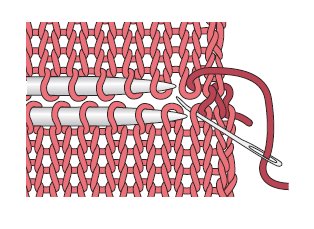
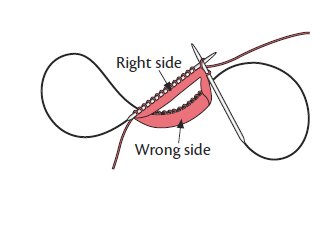
Read NextFlat Cable Slippers

